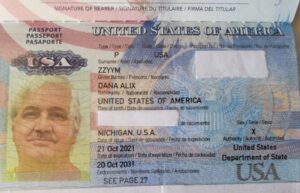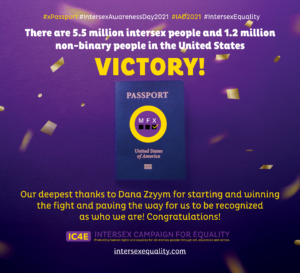Our A.D. is First Recipient of a US X Passport!
We finally did it! Today, our Associate Director Dana Zzyym became the first recipient of a US passport with an X sex/gender marker. Receiving the passport culminates a six year legal battle which began, fittingly, on Intersex Awareness Day (October 26th) 2015, when Zzyym’s groundbreaking lawsuit for a passport that accurately reflects them as neither male nor female, but intersex, was filed by Lambda Legal, the US’s oldest and largest LGBT legal organization.
As noted throughout by Zzyym throughout the case, they sought an X passport in order to end the social and legal erasure that facilitates irreversible, cosmetic surgeries on intersex children. Parents have consented to these surgeries for decades due to the notion that only males or females could exist in our society—a notion enforced by a two sex legal system. Zzyym decided that broadening the legal category of sex to include intersex people was a necessary step in obtaining civil rights and ending this oppressive practice. And we agreed.
The courts held in three favorable rulings that it was unconstitutional to force Zzyym to pick between two inaccurate sex markers, M/male or F/female, as evidence from their federal Veteran’s Administration (VA) medical records (Zzyym is a Navy veteran) demonstrates that they are neither. We note that, due to the longstanding use of the word “gender” to refer to physical “sex” in the US and other English speaking countries, the X has erroneously been referred to by the press as a “gender marker.”

While the passport is a first for the US, “X” has been in use as a third sex marker on passports since intersex Australian Alex MacFarlane obtained one in 2003. Currently, at least fifteen countries allow third markers, including Argentina, Austria, Australia, Canada, Colombia, Denmark, Germany, Iceland, Malta, the Netherlands, New Zealand, Pakistan, India and Nepal.
A few clarifications for those new to these issues:
- There are many intersex variations resulting in a wide range of outcomes (some of us look and/or feel very female or male, and some of us look and/or feel androgynous/in-between).
- Some intersex people are female by strict scientific definition (possessing ovaries and xx chromosomes), some male by strict scientific definition (possessing testes and xy chromosomes), and some neither male nor female by strict scientific definition (possessing ovo-testis, and/or chromosomal variations different from xx or xy).
- Intersex people, like all people, can have either binary or non-binary gender identities as adults.
As noted in Lambda Legal’s press release, the “X” is a “sex/gender” marker. As many are unaware, M and F sex markers have represented both sex and gender since they came into use in order to encompass the lived experience of intersex people. We refer to the fact that visible “gender,” not biological sex, has historically been used to identify many intersex people’s “sex” on birth certificates and other IDs, and continues to be. More recently, sex markers represent gender identity in the case of many trans citizens.
Why did intersex people select an “X” instead of an “I” for Intersex?
The choice, explained in depth here, was pragmatic and intentional. Pragmatic because the agency which governs passports, the ICAO, already offered an X marker (representing “Unknown”), and intentional in order to avoid creating an equally confining third category. As we know, intersex people are assigned M or F at birth, and millions identify with these binary sex/gender markers. Creating an “Intersex” marker governed by sex characteristics might call their identity and legal markers into question, which intersex pioneers of X markers found unacceptable.
In 2013, intersex movement leaders also adopted this “non intersex specific” approach to sex/gender markers in the Malta Declaration, a policy statement drafted by representatives from thirty leading intersex organizations from around the world that came together in Malta for the 3rd International Intersex Forum, including our founding director Hida Viloria (one of three selected intersex co-organizers of the Forum, including New Zealander Mani Mitchell and Argentinian Mauro Cabral), and representatives from fellow US intersex organizations InterACT and Intersex Justice Project. Among the Malta Declaration’s demands is that:
“All adults and capable minors should be able to choose between female (F), male (M), non-binary or multiple options. In the future, as with race or religion, sex or gender should not be a category on birth certificates or identification documents for anybody.”
In accordance with these goals, the US’s new federal X marker—like pre-existing F and M markers and pre-existing X markers statewide—represents both sex and gender/gender identity. It is for any intersex, non-binary, gender nonconforming, or trans American who wants one. As an organization committed to inclusion and coalition work we wouldn’t want it any other way.
We note that some intersex people will continue using F or M markers while others will obtain an X, and we support all these choices as self-determination is central to our mission. We also continue to support the greater goal of eventually abolishing sex/gender markers from IDs altogether, and are aware that recognizing diversity within previously binary categories has always been a formative step in abandoning them.
As noted by Lambda Legal: “The Intersex Campaign for Equality and its Founding Director, Hida Viloria, played a critical role in bringing Dana’s case forward.”
We are extremely proud to have participated in the lawsuit, which inspired an avalanche of similar efforts nationwide when it was filed in 2015. In September 2016, for example, intersex Californian Sara Kelly Keenan became the second US citizen to legally change their state sex/gender marker to “non-binary” (the first, a non-intersex Oregonian, has since changed their marker back to an M), and the recipient of first US intersex birth certificate. This led to California, and 23 states to date, enacting legislation offering X sex/gender markers for intersex, non-binary, trans and gender-nonconforming citizens.
We thank the US State Department and Secretary of State Antony Blinken, Lambda Legal—particularly lead attorney on the case, Paul Castillo—and, most especially, our very own Dana Zzyym for their incredible determination, dedication and fortitude in making this civil rights victory come true! As promised by the US State Department, it will be an available option for all US citizens as soon as necessary systems changes permit.

